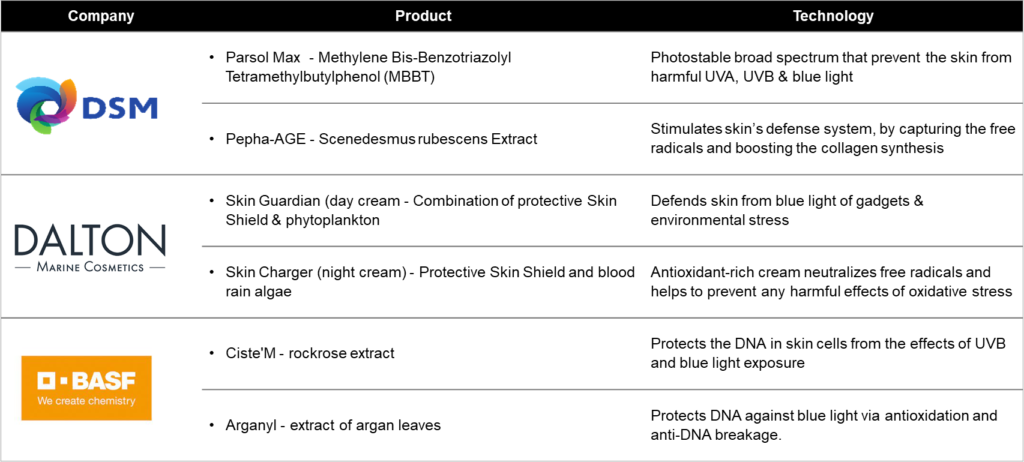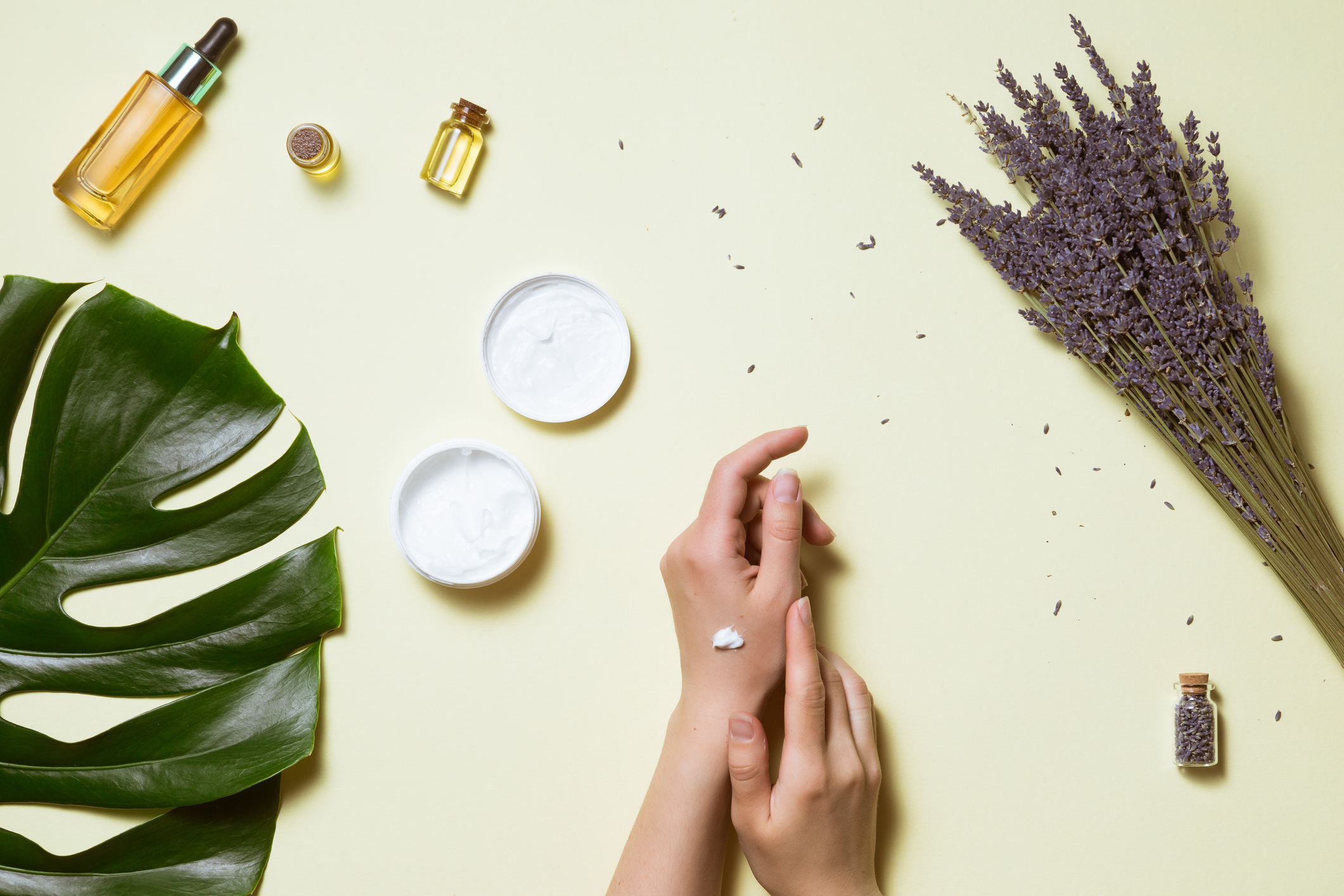Blue Light Protection: A new skincare challenge
Unknowingly, our daily exposure to electronic screens from our phones to our laptops, to tablets and TVs has damaging effects on the eyes and skin especially face and neck regions. Millennials and the Gen-Z population are the most exposed generations to digital lights spending extensive periods on digital screens which has been increased in the pandemic. A lot of research has been conducted and is still in progress to tackle the ill effects of blue light on the skin. A surge in blue-light-blocking skincare products and claims are being marketed to consumers at a growing rate.
How Blue Lights Affect Our Skin?

Blue light, or High-Energy Visible Light (HEV), is part of the visible spectrum of light emitted by the sun and consumer electronic devices. The blue end of the visible spectrum of light has a short wavelength and higher energy output. Due to these characteristics, it can penetrate deep into the skin and cause greater damage. So, blue light protection has great acceptance.
According to Brian Goodwin, Eminence Organics International Trainer, a person is exposed to blue light 13 hours a day while using cell phones or computer screens. At least 60% of people spend more than six hours per day in front of a digital device, as per the reports of a study.1 In an article by Harvard Medical School, the human body uses blue light from the sun to regulate natural sleep and wake cycles, also termed as circadian rhythm, due to an increase in nerve excitement, boost in alertness, enhanced reaction times, mood elevation, and feeling of well-being.
Problem
Blue light penetrates the skin far deeper into the subcutaneous layer compared to UV light (as seen in the pictorial depiction) and induces cellular dysfunction, DNA damage, collagen breakdown, and damaging elastin fibers. The bullet points below provide detailed events of skin damage due to blue light exposure:
- Skin aging: Studies indicate that blue light produces ROS and flavins (skin pigments), which mediate superoxide production and increase oxidative stress. The overexposure of ROS damages skin cells, which affects skin barrier function, skin aging, and melasma.
- Pigmentation: Irradiation on human skin causes free radicals to form, leading to oxidative stress on melanogenic precursors, resulting in immediate and persistent pigmentation.
- DNA damage: Continuous exposure to radicals damages the cellular antioxidant defense pathway, leading to permanent DNA damage.
- Collagen and elastin damage: Exposure induces the enzyme matrix metalloproteinase (MMPs) in skin cells, which induces photoaging by degrading collagen and inhibiting new collagen formation.
Blue Light Protection: Beating The Blues
In recent years, the number of blue light protection claims in new beauty products has increased as brands cater to the interest and awareness of consumers who want to buy blue light-shielding beauty products.
Aligning with consumers’ strong needs globally, Blue Light is developing blue light protection technologies with novel mechanisms and ingredients to succeed in the future market.
Novel Mechanism
- Exosomes: There are various formulations that use soybean to treat blue-light-assisted aging. However, recently, as an active moiety, Soybean plant cell-derived exosomes have shown unique & multiple benefits for treating skin problems. Research indicates that composition works by three different mechanisms. 1) Reduces apoptosis caused by blue or UV light & also lowers the skin temperature 2) minimizes the environmental stress induced by UV light or dust by increasing the expression of LEA protein that increases the resistance of cells to these external factors 3) In addition, the exosomes can protect the skin by activating autophagy of skin cells and maintaining and strengthening the skin barrier, and contributing to maintaining a healthy skin condition.
- Physical Filters: Innovative bio-based organic filters derived from Meldrum’s acid (p-hydroxycinnamic acid) have provided excellent UV protection properties, photostability, antiradical, & tyrosinase inhibition properties, which are better than compared common filters of octinoxate or avobenzone. These novel filters provide antiradical as well as UV absorption properties that mainly protect the skin from UV/ blue light without using any extra substance in the formulation. Additionally, these organic compounds lack agonist and antagonist properties towards receptors of the endocrine & central nervous systems, making them safer to use.
- Antioxidants: Recently, the fullerene filtrate in the cosmetic composition has shown positive activity in terms of blocking light in the UV region as well as the blue region (50% blocking rate). Naturally, it has also shown antioxidant, antibacterial, & skin whitening effects by reducing the expression of Reactive Oxygen Species (ROS). Fullerene derived from natural mineral sources such as Shungite is more suitable for use in cosmetic compositions due to its excellent formulation stability.
Blue Light Protection: Market Statistics
Consumers are increasingly concerned about the damaging effects of blue light and its threat to skin health. According to statistics, blue light protection beauty products are experiencing an immediate rise in interest.

Figure 2: Stats of blue light protection

Patent filing trend: Blue light protection is a relatively new area for patents; patent filings have increased significantly in the last 5 years. Technologies like natural products/ extracts, especially algae extracts and vitamin formulations, are among the top technologies claimed in recent patent filings. China is the major jurisdiction with the highest number of patent filings in the last period, followed by the USA, a major jurisdiction with high patent filings.

Marketed products: Increased exposure time to electronic screens and consumer awareness propelled the blue light protection product launches in the last 3 years. Companies have observed a significant increase in product launches, with more than 50% of the products claiming natural/botanical extracts for blue light protection. Companies have combined these protection technologies with skincare applications like sunscreen, moisturizing, hydration, and skin whitening products.
Key Players
Major players are ramping up their efforts to identify the degree of damage done by high-energy blue lights and formulate skincare solutions.

Table: Key players in blue light protection
Blue Light Protection: Future Perspective
With the majority of people continuing to be in touch with digital screens and natural light, the effect of blue light isn’t going anywhere anytime soon—aesthetician product blue light-centered skincare products will be a huge trend in the coming years. Multiple ingredients, such as marine or algae‐based ingredients, UV filters, natural extracts, antioxidants, and vitamins, are available on the market to fight against blue light‐induced skin damage. In the near future, researchers will continue to advance their research into the mechanism by which blue light damages the skin, and this will result in an increase in ingredients for blue light protection, new mechanisms, and tests to determine if products meet blue light protection claims.
Conclusion
Due to the global pandemic, the majority of people continue to be in touch with digital screens for longer, so the effect of blue light isn’t going anywhere anytime soon. Aesthetician products and blue light-centered skincare products will be a huge trend in the coming years. Multiple ingredients are available on the market to fight against blue light-induced skin damage. Moreover, these include marine or algae-based ingredients, UV filters, natural extracts, antioxidants, and vitamins.


